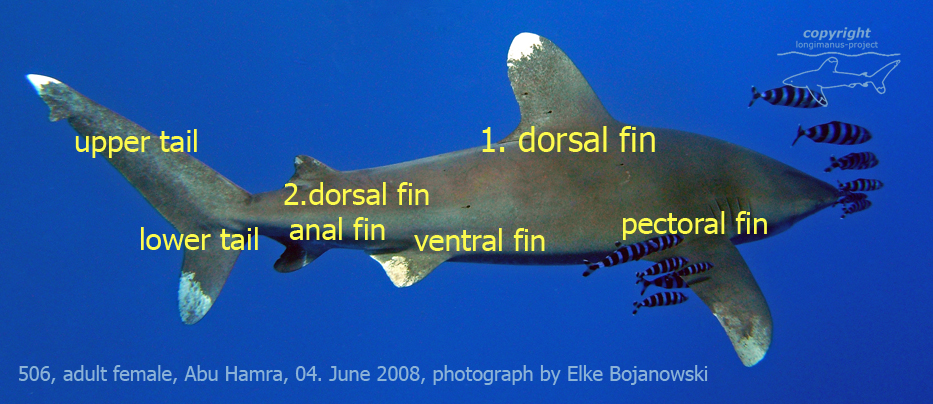the longimanus-project...
... was initiated in fall 2004, about 6 months into my work as a diveguide on live-aboards in the Egyptian Red Sea. After commonly sighting oceanic whitetip sharks on these diving safaris, it became obvious, that their natural markings allow for an easy individual identification (see below).
Originally trained in animal behaviour (specializing on dolphins), photo-identification was a familiar tool for me, used to collect basic data on e.g. population size, site fidelity, and social structure in marine mammals worldwide.
Aim of the Longimanus-Project is the detailed documentation of the occurrence of this shark species in the Egyptian part of the Red Sea, utilizing information that is readily available. In the long run, I hope the accumulation of data will contribute to reasonable, knowledge-based, protection efforts.
In a first phase, I collected digital underwater pictures and video clips between October to December 2004. These photographs were provided by divers, who were guests on board the diving vessels I worked on, and formed the base for the first identification catalogue of oceanic whitetip sharks in Egypt.
methods
The white and/or dark colour patterns on all fins are the primary tools to identify individual oceanic whitetip sharks. Additionally one can use the pigmentation pattern on the belly and the tail stock, as well as the grey-to-white line from the eye to the pectoral fin.

The photograph shows the natural markings useful to individually identify oceanic whitetip sharks; the main feature being the broad, rounded first dorsal
fin.
dorsal fin |
pectoral fin |
ventral fin |
anal fin |
lower tail |
upper tail |
||
right |
 |
 |
 |
 |
 |
 |
|
left |
 |
 |
 |
 |
 |
 |
situation today
After another five complete fall and winter seasons (2005/2006, 2006/2007,
2007/2008, 2008/2009 & 2009/2010) and about 20.000 photographs later, the identification
catalogue at present contains more than 500 different animals. A lot of
them were only seen (or: photographed) once, others were around for some
period of time. One specific female (506, s.a.) has been photographed every
single year since the onset of the study, spanning the seven years from 2004
- 2010. Besides two years where she has been sighted off the island of Zabargad
and off Abu Hamra [Elphinstone], her favourite "hang-out" is Abu
Kizan [Daedalus Reef]. She is also one of the few oceanics that have been photographed in the first half of 2010.
outlook
Still using blue o two's safari boats, Blue Horizon, Blue Fin & Blue Melody, as the major study platform, the project will continue this year (2010). Ideally, it will involve fitting some of the Oceanics with satellite tags! But the basic photo-identification study continues as well. Besides recent pictures, I am still very interested in including and analysing photographs from former years.
This is where I need your help! The sidebar contains all the information
you need to send me your underwater photographs of Oceanic Whitetips Sharks.
other news
Under the umbrella of HEPCA, the project will now be embedded into a larger Red Sea shark project. Beside the electronic tagging, it will involve a monitoring program with the help of volunteers, additional photo-identification projects, e.g. on grey reef sharks (Carcharhinus amblyrhynchos) and silky sharks (C. falciformis), and dedicated surveys. Detailed information on the the Red Sea Shark project will soon be available at www.hepca.com and www.redseasharks.org.
THANK YOU!


Any underwater images of oceanic whitetip sharks could
be helpful in advancing our knowledge of this shark species in the Red
Sea. If you have any photographs- or know of people that do - it would
be highly appreciated if you would send those to me!
VERY IMPORTANT!
Please include the information on WHERE (which
reef) and WHEN (which date) the respective pictures where taken, plus
- ideally -the full name of the photographer(s) !
You have a choice of different methods to send picture files to me. In the contact-section, you find my email address, a link to directly upload images, as well as my postal adress in Germany.
The photographs are NOT used for commercial purposes, but only to gain information. I do take it though that you agree to the publication of single pictures or picture excerpts within a scientific frame. Any request beyond that, I would reconfirm with you in advance and - naturally - give you all credits. So please include your name and contact information (if possible, an email-adress) when sending any pictures.
And although it might take me some time to answer - since I do spent quite a lot of time on the sea - any contribution will be highly appreciated !!!